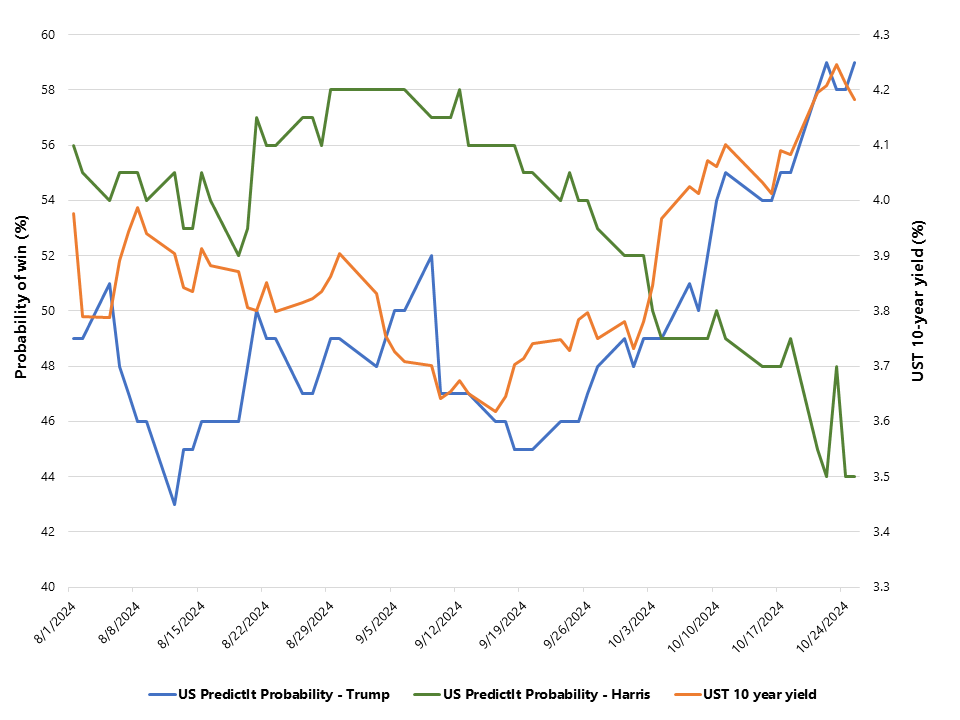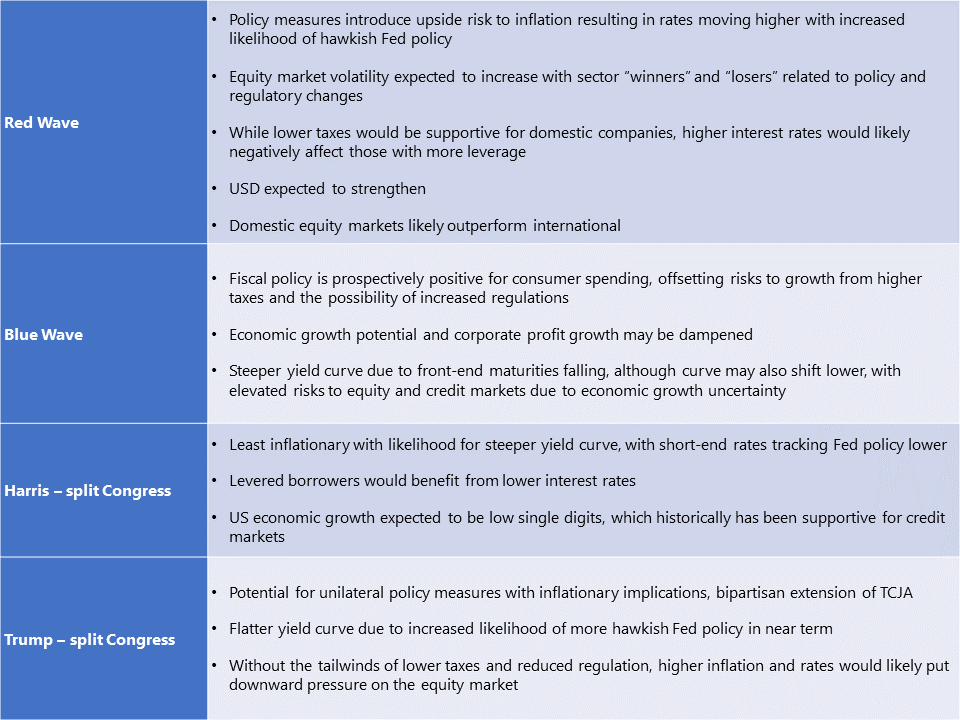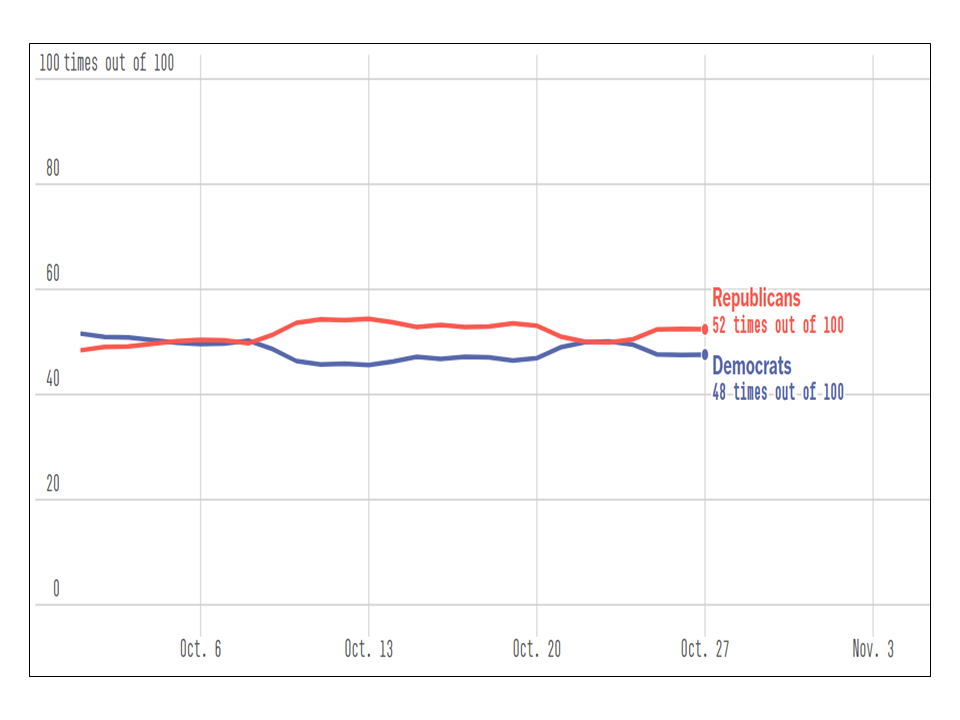10-year Treasury yield has risen with the higher probability of a Trump win

Have the Markets Decided?
Treasury yields have shifted higher this month across the curve by 40-50 basis points, as investors are pricing in a higher rate of expected inflation. In fact, the 5-year inflation breakeven rate has risen from a low of 1.9% on September 10, the day of the presidential debate, to a current high of 2.3%. As shown in the graph above, this has corresponded with an increasing probability that former President Trump wins the election per PredictIt, a prediction-related market investors use to bet on election outcomes. Statistically, this explains about 75% of the move in the 10-year yield since the beginning of September.
Why is a Trump presidency inflationary? We have outlined our thoughts regarding potential market and related economic implications in the table that follows.
AAM’s View of Market and Related Implications for the U.S. of the U.S. Election

Potential Implications
What are the risks if the market is wrong?
With the prediction market not only forecasting a Trump presidency but a Republican “sweep,” a split Congress or Harris presidency would likely result in falling US Treasury yields and a rally in equity markets outside the U.S. We would also expect the US dollar to weaken.
What sectors might be affected by a Trump Presidency or a “red wave?”
In terms of those expected to benefit, the expectation of reduced regulation would likely benefit industries like financials and fossil fuels. For example, the exporting of Liquified Natural Gas (LNG) is likely to increase. Additionally, geopolitical shifts such as enforcing Iran sanctions would have ramifications on various industries. Companies with a high degree of revenue generated domestically and/or domestically focused supply chains would likely benefit if tariffs were raised. While multi-layered, the auto industry could benefit.
Industries such as healthcare would likely be negatively affected if Democratic policies were repealed. The same for those industries benefiting from spending related to the Inflation Reduction Act. That said, much of this spending has been in “red” states. From a market perspective, the tax-exempt municipal sector would be affected if the SALT deduction were eliminated or made permanent, but more significantly, an elimination of the tax exemption would have material consequences. We view that as a tail-risk event.
Daily forecast of Probability of Senate control

Daily forecast of Probability of House control

Disclaimer: Asset Allocation & Management Company, LLC (AAM) is an investment adviser registered with the Securities and Exchange Commission, specializing in fixed-income asset management services for insurance companies. Registration does not imply a certain level of skill or training. This information was developed using publicly available information, internally developed data and outside sources believed to be reliable. While all reasonable care has been taken to ensure that the facts stated and the opinions given are accurate, complete and reasonable, liability is expressly disclaimed by AAM and any affiliates (collectively known as “AAM”), and their representative officers and employees. This report has been prepared for informational purposes only and does not purport to represent a complete analysis of any security, company or industry discussed. Any opinions and/or recommendations expressed are subject to change without notice and should be considered only as part of a diversified portfolio. Any opinions and statements contained herein of financial market trends based on market conditions constitute our judgment. This material may contain projections or other forward-looking statements regarding future events, targets or expectations, and is only current as of the date indicated. There is no assurance that such events or targets will be achieved, and may be significantly different than that discussed here. The information presented, including any statements concerning financial market trends, is based on current market conditions, which will fluctuate and may be superseded by subsequent market events or for other reasons. Although the assumptions underlying the forward-looking statements that may be contained herein are believed to be reasonable they can be affected by inaccurate assumptions or by known or unknown risks and uncertainties. AAM assumes no duty to provide updates to any analysis contained herein. A complete list of investment recommendations made during the past year is available upon request. Past performance is not an indication of future returns. This information is distributed to recipients including AAM, any of which may have acted on the basis of the information, or may have an ownership interest in securities to which the information relates. It may also be distributed to clients of AAM, as well as to other recipients with whom no such client relationship exists. Providing this information does not, in and of itself, constitute a recommendation by AAM, nor does it imply that the purchase or sale of any security is suitable for the recipient. Investing in the bond market is subject to certain risks including market, interest-rate, issuer, credit, inflation, liquidity, valuation, volatility, prepayment and extension. No part of this material may be reproduced in any form, or referred to in any other publication, without express written permission.